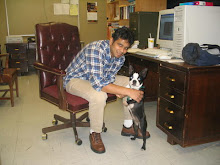There has been a recent post on the HCLS Wiki comparing the relative strengths and weaknesses of the various proposed solutions to the unique resource identifier (URI) problem on the Semantic Web. A matrix of the various proposals with their desired features has been created. What got my noodle in this matrix was a "clickability" feature. Now going by the definitions of clickability from the Human Computer Interaction course back in Graduate School, I suppose an end user should be able to click on a URI that identifies a node and access a human friendly definition of the resource.
This is bothersome. Why would a naive end user want to access a node? At best, this would be analogous to looking through an XML file. Now how much of this would John Doe really "get"? In the early days of XML, customized tags with DTDs were touted as one of its main features. You could use CSS or XSLT for rendering it on a browser. That changed very quickly. Now we use XML transparently in databases and Web services without the need to view concept and message definitions on a User Interface such as a browser. If clickability were a desired feature of the message formats and protocols defined in SOAP and WSDL, how much of a WSDL definition would make sense to a naive end user? And why do we have to bother with writing an XSLT program to render WSDL on an interface for an end user? Would it make any sense?
I believe the Semantic Web will be transparent to the naive end user. John Doe will continue using seemingly unstructured raw text data that is formatted for his easy consumption on a Web user interface. The various concepts and relations in the text he reads will hook into logically grounded definitions in an ontology, after the fashion of hyperlinks. This is what will enable John Doe to run informed searches through the Web and invoke agent programs that will help him plan a vacation to Florida by using sophisticated reasoning and planning algorithms. The Semantic Web with its carefully curated ontologies will exist at a "higher level of abstraction" from the Web that is accessed by John Doe, but should not be readily visible to him
Thursday, July 5, 2007
Subscribe to:
Comments (Atom)
